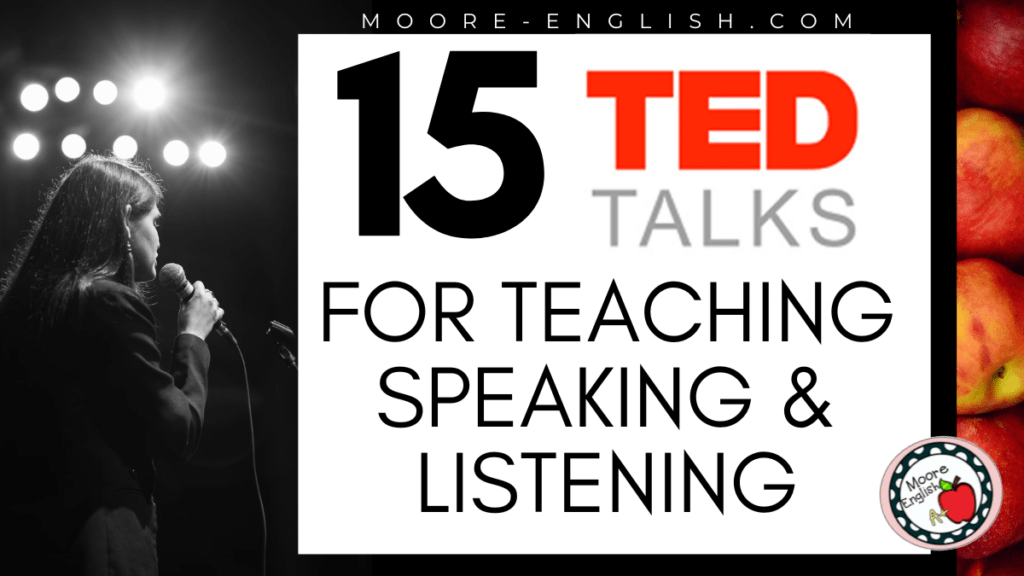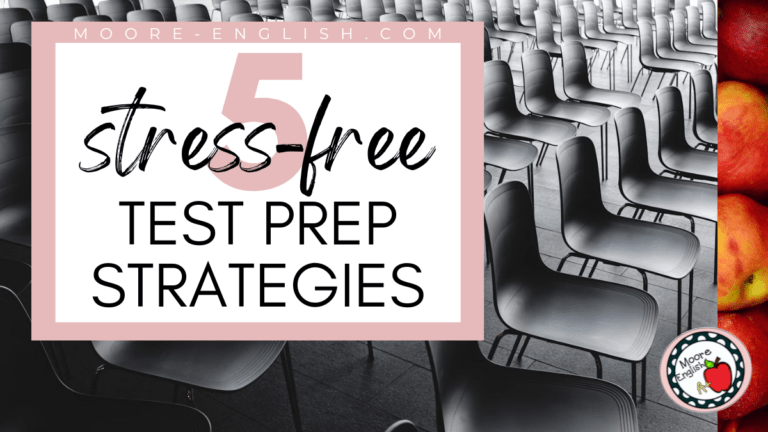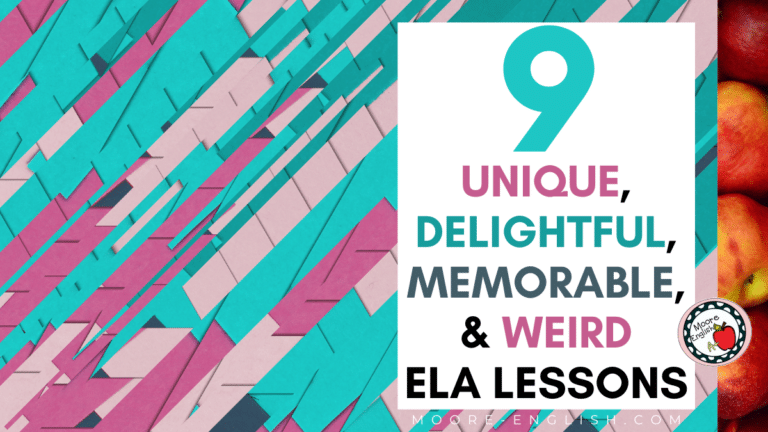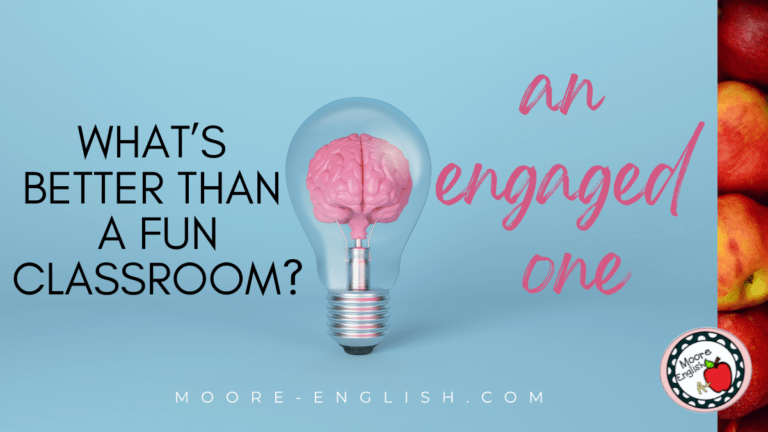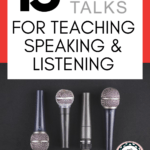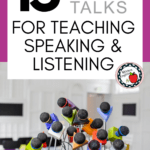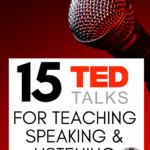Classrooms systems are my bread and butter. I have a process or a procedure for everything:
- Looking for a sponge activity? Grab task cards.
- Need supplies? Check out the May I Borrow Shelf.
- Tired of students lining up at the door? I have a plan for that!
- Getting overwhelmed with grading? Implement the laundry method.
Until recently, I did not feel like I had a strong process or procedure for teaching speaking or listening skills. It always felt kind of hit or miss. If a unit ran long, I would cut a speaking or listening activity, especially a listening activity.
However, I’ve recently taken the time to streamline my speaking and listening lessons by collecting these quick, engaging TED Talks. I’ve also paired each of these TED Talks with a specific speaking or listening skill.
This post this post may contain affiliate links. Please read the Terms of Use.
TED Talks for Teaching Listening Skills
Listening skills are so easily overlooked in the ELA classroom. It’s often said that “we’re all reading teachers,” and it is also true that we are all listening teachers. Helping students become more conscious, thoughtful, and compassionate listeners benefits everyone. Here are some TED Talks that suit listening skills so well:
- 5 ways to listen better by Julian Treasure provides students with strategies for better listening and also sets them up with a chance to reflect on their own listening skills. Treasure has several other TED Talks in this same vein, too!
- How to step up in the face of disaster by Caitria and Morgan O’Neill is a partner speech. One of my state listening standards emphasizes the importance of collaboration. The way the O’Neill sisters work together opens up a conversation about working together to achieve a common goal.
- What it’s like to live on the International Space Station by Cady Coleman is fascinating! However, Coleman speaks quickly, so this is a good speech for practicing close listening. It’s also a good speech for evaluating the importance of a speaker’s rate.
TED Talks for Teaching Speaking Skills
A formal presentation is a requirement of my state standards, so I always have to think about how to prepare students for making such a presentation. In the past, I have struggled to find student-appropriate examples. There’s a lot to think about when choosing a video: will students find it engaging? Is the topic appropriate? How long is the talk?
Managing all of those questions can be overwhelming, so putting this collection together was helpful for me.
- Smart People Don’t Get Offended by Dustin Anderson is short and to the point. However, Anderson has many qualities of an effective speaker, so this is a good holistic speech. This is a perfect speech for students to assess. I love giving them the rubric and asking them to evaluate the quality of the speech.
- A life lesson from a volunteer firefighter by Mark Bezos does a great job using humor to communicate an important message. This opens up a conversation about how to use humor, what humor is appropriate, and what humor to avoid.
- The fastest ambulance? A motorcycle by Eli Beer is about United Hatzalah, a volunteer emergency medical services company Beer founded in Israel to fill gaps in emergency services. Beer’s Jewish heritage affects his mission, and he draws on Yiddish and Hebrew words. This is a good example of a speech that opens up conversations about knowing your audience.
- A new mission for veterans — disaster relief by Jake Wood, and Try something new for 30 days by Matt Cutts, and The best gift I ever survived by Stacey Kramer have clear main ideas. All three speeches help students understand the moves effective speakers make to emphasize their main idea.
- Finally, Every kid needs a champion by Rita Pierson is such a tried-and-true speech for teachers. However, for students, this is a good video for discussing tone, purpose, and persuasive language.
All About Visual Aids
When my students present, they want to rely on Google Slides. While a slideshow has a time and a place, there’s so many other visual aids from which to choose. These TED Talks expose students to diverse visual aid options and help emphasize the point that no one wants you to read that slideshow aloud!
- How to start a movement by Derek Sivers is funny. As a bonus, Sivers’ use of a visual aid is unique and engaging.
- Don’t suffer from your depression in silence by Nikki Webber Allen only has one visual aid, but, oh man, is it powerful! I love this TED Talk as a way to show students that sometimes less is more.
- Grit: The power of passion and perseverance by Angela Lee Duckworth is a good example of how to incorporate data without making it overwhelming.
- Photos from a storm chaser by Camille Seaman and Archaeology from space by Sarah Parcak both open with anecdotes. My students often struggle to develop engaging but meaningful and relevant hooks, so these are perfect examples! Plus, both of these TED Talks have wonderful visual aids.
Honorable Mentions
I use TED Talks throughout the year, and some of my lessons are not speaking and listening focused. But I couldn’t write about TED Talks without mentioning these gems:
- “Courage is Contagious” by Damon Davis is a speech I paired with these texts. It was such a good way to practice synthesize across media.
- “The Danger of a Single Story” by Chimamanda Ngozi Adichie is such a powerful speech that I teach it every year.
- “Why city flags may be the worst-designed thing you’ve never noticed” by Roman Mars is an unexpected gem for back to school. I know it’s a weird suggestion, but this is a perfect first week speech.
- I also adore TED-ed, and I’ve collected all my favorites in one TED-ed Listening Guide Bundle. I’ve also shared all about them here.



